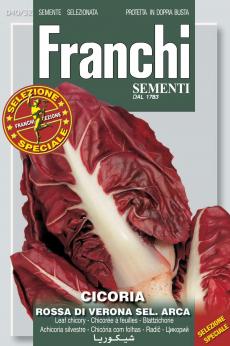
Chicory, Cicoria Rossa Di Verona Sel. Arca
Chicory, Cicoria Rossa Di Verona Sel. Arca. Mid-late. is this one of the Franchi Special Selections reserved for vegetables of exceptional merit. In addition to stunning color, this forms a nice tight head. Appropriate for the specialty trade. Grow like any red radicchio. it has a contained head of fair dimensions with large crunchy ribs and no veining and rounded, meaty leaves and white ribs which are tender and crunchy.
An outstanding selection of a solid heading radicchio with a 4-6” tall, elongated shape. Deep red/purple leaves with broad white mid-ribs are nice and crunchy with the tangy bitterness that radicchio is known for. We loved this variety for our winter CSA, as the tight wrapping on the heads meant that even when outer leaves were damaged from extreme cold, there was still a marketable head just a few leaves down. Also great harvested young as a loose head or for salad mix as cut-and-come-again greens. Resistant to low temperatures. 85 days from direct seed. approx. 2400 seeds.
Radicchio Rossa di Verona sel. Arca: Early. Radicchio and Chicory In the UK we tend to think of chicories as the green-leafed varieties and radicchios as the types with red leaves, although both are from the chicory family and both share a similar pleasant bitter taste that adds so much to a humble salad - . Sometimes people comment that their home-grown chicory and radicchio is too bitter. This is easily remedied. A trick used a friend in Venice is to add a teaspoon of sugar or honey to the dressing. This doesn't make the dressing sweeter, it simply counterbalances the bitterness of the chicory. Another tip is to soak the leaves for 30 minutes in cold, salted water, which will extract some of the bitter properties. Be sure to rinse them before serving.
Approx. 2400 seeds.
More on Chicories and Radiccios:
You could also grow a cutting chicory, which will always be milder than one that forms a head. All chicories can be added to a salad and, besides providing different textures and flavours, they have beneficial properties - aiding digestion and containing mineral salts and vitamins. Radicchios, in addition to being eaten fresh like green chicories, can be cooked and make a delicious vegetable. A Treviso or Palla Rossa (red ball) chicory, for example, can be cut up and pan-fried in a little olive oil, or brushed with olive oil and salt and grilled. The flavour changes when cooked, becoming sweet and caramelly, with a pleasant bitter aftertaste that is really pleasing on the palate. There's quite a difference between the two types. Chicories (the green ones), are treated much like lettuces in that they have the same growing season and are not generally frost hardy (sow from February to September/October). These are best eaten raw in salads. Radicchios are generally from the alpine northern part of Italy and are completely hardy. They are generally sown much later and harvested through the winter. In fact, many radicchio varieties actually need the cold to turn red. Some varieties can withstand temperatures of -15C and can be harvested outside in the UK from November to April. Cold is what makes radicchio turn red, and herein lies the problem. If you buy seed and sow it in March, April or May you end up with a big green head like a Romaine lettuce, which turns hairy and so bitter that it is inedible. The reason for this is that it's being planted with cold and grown into heat, when in reality you need to sow it with heat (around the end of August) and grow it into the cold. We always plant ours when we come back from a summer holiday and the plant will look green, but then, come October, you see a slight red tinge and by November, December, the radicchio turns red. The colder it is, the redder - and sweeter - radicchio is.
